Peep cpap - Study guides, Class notes & Summaries
Looking for the best study guides, study notes and summaries about Peep cpap? On this page you'll find 563 study documents about Peep cpap.
Page 2 out of 563 results
Sort by
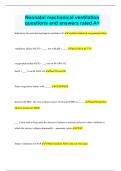
-
Neonatal mechanical ventilation questions and answers rated A+
- Exam (elaborations) • 13 pages • 2024
- Available in package deal
-
- $9.99
- + learn more
Neonatal mechanical ventilation questions and answers rated A+ Indications for neonatal mechanical ventilation (2) ventilator failure & oxygenation failure ventilatory failure PaCO2 > ____ torr with pH < ____ paco2 60 & ph 7.24 oxygenation failure PaO2 < ___ torr on 80-100% O2 SaO2 <____% on 80-100% O2 Pao2 50 sao2 88 Treat oxygenation failure with _____ CPAP/PEEP Increase the FRC- the most common causes of decreased FRC is _____ Infant Respiratory Distress Syndrome...
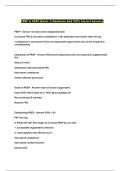
-
PEEP & CPAP (Exam 1) Questions And 100% Correct Answers
- Exam (elaborations) • 5 pages • 2024
- Available in package deal
-
- $9.99
- + learn more
PEEP & CPAP (Exam 1) Questions And 100% Correct Answers...
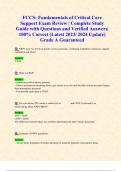
-
FCCS: Fundamentals of Critical Care Support Exam Review | Complete Study Guide with Questions and Verified Answers| 100% Correct (Latest 2023/ 2024 Update) Grade A Guaranteed
- Exam (elaborations) • 72 pages • 2023
- Available in package deal
-
- $11.49
- + learn more
FCCS: Fundamentals of Critical Care Support Exam Review | Complete Study Guide with Questions and Verified Answers| 100% Correct (Latest 2023/ 2024 Update) Grade A Guaranteed Q: NPPV uses two levels of positive airway pressure, combining modalities of pressure support ventilation and what? Answer: CPAP Q: What is CPAP? Answer: continuous positive airway pressure - Allows spontaneous breathing from a gas source at an elevated baseline system pressure (higher than atmospheric pr...
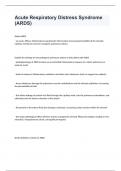
-
Acute Respiratory Distress Syndrome (ARDS) correctly answered 2024
- Exam (elaborations) • 10 pages • 2024
- Available in package deal
-
- $15.99
- + learn more
Acute Respiratory Distress Syndrome (ARDS)Define ARDS - an acute, diffuse, inflammatory lung disorder that involves increased permeability of the alveolar-capillary membrane and non-cariogenic pulmonary edema Explain the etiology of noncardiogenic pulmonary edema in the patient with ARDS - pathophysiology of ARDS involves an uncontrolled inflammatory response to a direct pulmonary or systemic insult - leads to release of inflammatory mediators and other toxic substances (such as oxygen...

-
CRNA Board Questions with correct answers
- Exam (elaborations) • 105 pages • 2023
- Available in package deal
-
- $14.99
- + learn more
Positive end expiratory pressure (PEEP): 1. decreases dead space ases venous return to the heart 3. decreases intrapulmonary shunting 4. decreases extravascular lung water CORRECT ANSWER Positive end expiratory pressure (PEEP): decreases intrapulmonary shunting The major effect of PEEP is to increase FRC and tidal ventilation above the closing capacity. This results in a decrease in intrapulmonary shunting. Neither PEEP nor CPAP decrease extravascular lung water. By increasing intratho...
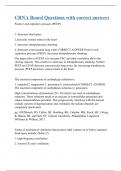
-
CRNA Board Questions with correct answers
- Exam (elaborations) • 105 pages • 2023
-
- $15.49
- + learn more
Positive end expiratory pressure (PEEP): 1. decreases dead space ases venous return to the heart 3. decreases intrapulmonary shunting 4. decreases extravascular lung water CORRECT ANSWER Positive end expiratory pressure (PEEP): decreases intrapulmonary shunting The major effect of PEEP is to increase FRC and tidal ventilation above the closing capacity. This results in a decrease in intrapulmonary shunting. Neither PEEP nor CPAP decrease extravascular lung water. By increasing intratho...

-
ABG FINAL EXAM SOLVED COMPLETE QUESTIONS AND CORRECT DETAILED ANSWERS (VERIFIED ANSWERS)
- Exam (elaborations) • 18 pages • 2024
-
- $12.99
- + learn more
ABG FINAL EXAM SOLVED COMPLETE QUESTIONS AND CORRECT DETAILED ANSWERS (VERIFIED ANSWERS) 1. What does the steep part of the oxy Hb curve represent? - ANSWER between 10 and 60mmHg- this is where O2 will rapidly bind with Hb 2. What factors affect the oxy Hb diss. Curve? - ANSWER changes with temp, CO2, 23DPG and PH. 3. A decreased affinity means? - ANSWER A left shift- temp, 23 dpg or CO2 decreases, this leads to an increase in PH 4. How does a decrease or increase in...
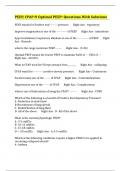
-
PEEP, CPAP & Optimal PEEP: Questions With Solutions
- Exam (elaborations) • 3 pages • 2024
- Available in package deal
-
- $8.99
- + learn more
PEEP, CPAP & Optimal PEEP: Questions With Solutions
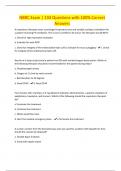
-
NBRC Exam | 134 Questions with 100% Correct Answers
- Exam (elaborations) • 48 pages • 2024
-
- $12.99
- + learn more
A respiratory therapist notes a prolonged inspiratory time and variable cycling to exhalation for a patient receiving PS ventilation. The circuit is verified to be intact. The therapist should NEXT: a. Check for right mainstem intubation b. Evaluate for auto-PEEP c. Check for integrity of the endotracheal tube cuff.d. Evaluate for mucus plugging - c. Check for integrity of the endotracheal tube cuff. Results of a sleep study reveal a patient has OSA with marked oxygen desaturation. Which o...

-
TMC Exam B Questions Correctly Answered 2024.
- Exam (elaborations) • 125 pages • 2024
- Available in package deal
-
- $10.49
- + learn more
TMC Exam B Questions Correctly Answered 2024. A patient with a PBW of 55 kg (121 lb) is receiving VC, A/C ventilation. Ventilator settings and blood gas analysis results are: FIO2 0.70 Mandatory rate 14 VT 350 mL PEEP 5 cm H2O pH 7.35 PaCO2 35 mm Hg PaO2 40 mm Hg HCO3- 19 mEq/L BE -6 mEq/L SO2 (calc) 74% A respiratory therapist should recommend A. changing to SIMV mode. B. increasing to 10 cm H2O PEEP. C. changing to 5 cm H2O CPAP. D. increasing to 400 mL VT. -...

How much did you already spend on Stuvia? Imagine there are plenty more of you out there paying for study notes, but this time YOU are the seller. Ka-ching! Discover all about earning on Stuvia


